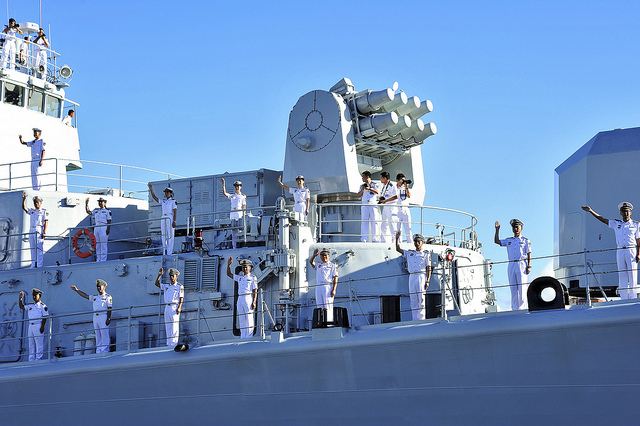With six-plus-years of Chinese Gulf of Aden anti-piracy operations and China’s first submarine deployments to the Indian Ocean, considering possible support facilities for the People’s Liberation Army Navy (PLAN) in the Indian Ocean Region (IOR) isn’t just for those theorizing a “String of Pearls” anymore. The U.S. Department of Defense itself forecasts that within the coming decade Beijing will establish one or more facilities capable of providing significant, if still limited, logistical support. The IOR is attracting increasing Chinese and American attention, with the latest U.S. Maritime Strategy referring to the “Indo-Asia-Pacific” and the previous commander of the U.S. Pacific Command describing its area of operations extending “from Hollywood to Bollywood.” With IOR geopolitics thus receiving growing outside attention, where China will ultimately locate its naval logistics points is an increasingly important question.
Such “places not bases” are unlikely to spring from nowhere. Instead, to plot where China’s navy may be heading the IOR, it helps to review where it’s been. That’s because establishing access points tends to be a long-term endeavor, based on enduring fundaments observable from outside. Naval facilities generally require (1) reliable political support in a stable host nation, (2) robust logistics infrastructure, and (3) sufficient draft for all major ships.
On that basis, the patterns represented in Exhibit 1 (below) are instructive, but hardly surprising. Leaving aside the potential ports of the future colored in white (many of which receive Chinese investment, but remain under development), several dynamics stand out.
First, only two ports are colored red (indicating more than 20 PLAN port calls): Port Salalah, Oman and Djibouti. Only one is colored yellow (10-20 port calls): Aden, Yemen. In terms of both political support/stability and infrastructure, they are in two separate categories. Oman and Djibouti are both resource-limited oases of stability in geopolitically complex regions which seek economic and political benefits by cultivating positive strategic relations with diverse outside powers. Short of a close political alliance and a society where prosperity undergirds stability yet risk of popular basing opposition is low (to the extent that such a combination exists), those conditions are about as good as it gets for potential IOR host nations. While there is no public discussion of a formal Chinese access point in Oman, Port Salalah has achieved de facto facility status. Aside from China’s first anti-piracy task force (which has only several port calls, by the supply ship only), all twenty thus far have called there. Djibouti has enjoyed nearly as many PLAN visits; now its leader asserts publicly that he has offered China a naval base and that the two sides are in negotiations. By contrast, even before it sunk into civil war, Yemen was clearly less stable. Between observing the USS Cole incident and reviewing China’s own detailed regional knowledge, Chinese planners likely decided not to give Aden equal emphasis with Salalah and Djibouti relatively close by.
Facilities likewise put Salalah and Djibouti in the top tier, over Aden. Salalah supports limited ship repairs. This is nothing to scoff at; few ports in the developing world offer robust repair capacity—a major navy must typically develop its own logistics train. To date, PLAN vessels have typically called on Salalah for replenishment of diesel fuel, water, food, and perishables; as well as crew liberty. Djibouti too allows for limited ship repairs; PLAN ships replenish there. But its infrastructure likely has even greater potential, as the U.S., France, and Japan already enjoy dedicated bases. Its use now suspended indefinitely, Aden until recently offered simpler fare. Another port to watch is Karachi. Pakistan’s foremost commercial and naval port, it has better repair facilities than most in the region. So what could be better than a solid setup on the territory of an “all weather friend”? While the PLAN has already called more than five times there, the next-most after the aforementioned “big three,” only Aden’s virtual closure offers Karachi prospects of gaining third place in PLAN visits. Perhaps Beijing worries about physical security and the appearance of excessively close military interactions with Pakistan, already the subject of serious concern (and far greater media speculation) in neighboring India. Time will tell…
The third key factor informing basing utility is water depth. For a port to be truly useful, it must accommodate a navy’s largest ships. As Exhibit 2 (below) indicates, the vast majority of ports considered here meet a basic test.
Port Depth (meters)
Save for Sittwe, Myanmar, all port listed above easily accommodate the seven-meter draft of the Type 071 Yuzhao-class, currently China’s largest amphibious vessel. Here again, Djibouti and Salalah lead with 18 and 17.5 m respectively. Another port to watch is Victoria, Seychelles, where Foreign Minister Jean-Paul Adam reportedly invited China to establish anti-piracy base in 2012. While Sri Lanka already has 16 and 13 m ports in Colombo and Trincomalee, it is projected to gain a 17 m port when Hambantota comes online over the next decade or so. Tanazania’s planned Bagamoyo port could have 12-14 m draft when completed ca. 2017. The PLAN may well have further options in years to come.


